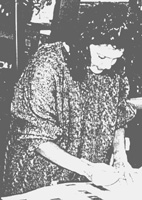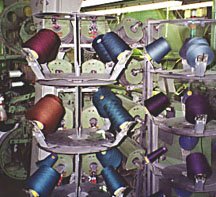The William McDonough Collection
Part 1
Prepared by Matthew M. Mehalik, under the direction of Michael E. Gorman, School of Engineering &
Applied Science at the University of Virginia, Andrea Larson, Assistant Professor of
Business Administration at the Darden Graduate Business School, University of Virginia,
and Patricia Werhane, Ruffin
Professor of Business Ethics at the Darden Business School, University of
Virginia. Partial Support for this project was supplied by grants from the Ethics and Values
in Science program of the National Science Foundation, the Batten Center for
Entrepreneurial Leadership at the Darden School, University of Virginia and the Geraldine R. Dodge Foundation.
The conclusions are the responsibilities of the authors and do not reflect the views of the
foundations. Copyright (c) 1996 by the School of Engineering and Applied Science of the
University of Virginia and the University of Virginia Darden School Foundation. All Rights
Reserved.[1].
A hardcopy version of this case, with supporting teaching materials,
may be ordered from the
Darden Case Bibliography,
reference code E-0099.
This is the banner of the next industrial revolution.
-- William McDonough
The contract textile business is about offering choice, not
volume.
-- Susan Lyons
Developing an Environmentally Intelligent Fabric [2]
Susan Lyons, Vice President of Design at DesignTex, a firm specializing in the
design and manufacture of textiles for commercial interiors, knew the
importance of looking ahead to the next design breakthrough. In February of
1991, she had helped launch a new line of fabrics called the Portfolio
Collection, a design that evolved out of collaboration with famous
architects, Aldo Rossi, Robert Venturi, Denise Scott Brown and Richard Meier.
This collection was provocative in its aesthetic sense, and it also demonstrated
that well-designed fabrics could be marketed at reasonable prices.
 Although Ms. Lyons was proud of the new collection, she wanted the next design to
focus on an issue, not just be a change in aesthetics. The issue of
environmental responsibility seemed perfect. "Green" was popular in
the trade literature and in the general media, and she had been receiving
inquiries from DesignTex's customers about how environmentally
responsible DesignTex's products were. Her desire to pursue an
environmental agenda was not, however, simply the result of customer demand. It sprang from
some deep personal beliefs about environmentalism that reflected her mother's influence. Lyons'
mother had been "way ahead of her time,": she had been recycling
trash and other items and had been conservation-minded back in the 1960's
when Lyons was growing up. These childhood experiences made Lyons
sensitive to environmental concerns, and she had a strong impulse
to act upon them.
Although Ms. Lyons was proud of the new collection, she wanted the next design to
focus on an issue, not just be a change in aesthetics. The issue of
environmental responsibility seemed perfect. "Green" was popular in
the trade literature and in the general media, and she had been receiving
inquiries from DesignTex's customers about how environmentally
responsible DesignTex's products were. Her desire to pursue an
environmental agenda was not, however, simply the result of customer demand. It sprang from
some deep personal beliefs about environmentalism that reflected her mother's influence. Lyons'
mother had been "way ahead of her time,": she had been recycling
trash and other items and had been conservation-minded back in the 1960's
when Lyons was growing up. These childhood experiences made Lyons
sensitive to environmental concerns, and she had a strong impulse
to act upon them.
Such a breakthrough, thought Lyons, would maintain DesignTex's leadership in
the commercial-fabrics design market. DesignTex was vying to be the largest member of the
Association of Contract Textiles (ACT), the industry trade organization. Located
in New York, DesignTex worked with over forty (40) mills around
the world, many of which manufactured the designs created by
DesignTex.
DesignTex was also a member of the Steelcase Design Partnership, a collection
of design industries purchased in 1989 by Steelcase, a giant corporation located in Grand
Rapids, Michigan, that manufactured office furniture and supplies. Steelcase
formed this partnership to capture a market that otherwise eluded the firm. Although
the company was able to turn out huge amounts of products very profitably,
it was not responsive to customers such as architects, who demanded specialty or
custom designs. Small, nimble and entrepreneurial
companies were able to meet the demands of this growing market better than Steelcase,
and DesignTex was such a company.
In order to maintain DesignTex's ability to respond to the rapidly-changing,
custom design market, Steelcase permitted DesignTex's management to operate
autonomously. In fact, as a fabric supplier, DesignTex sometimes competed against Steelcase for
contracts. Steelcase typically brought in DesignTex
as a consultant, however, in matters involving specialty fabrics design. Susan Lyons
summarized the relationship, "DesignTex is very profitable, and Steelcase receives a large
amount of money from DesignTex's operation with no oversight, so Steelcase is
happy to let DesignTex do its own thing. However, this situation could change if
DesignTex's profitability began to decline." By taking the lead in the
still volatile environmental market, Lyons hoped DesignTex would maintain its
autonomy.
 To launch her project, she began surveying the trade literature, contacted yarn spinners
who claimed to be environmentally
"correct," and paid attention to competitors who were also attempting to enter
this market. The work was difficult, because (1) she was also looking at approximately
40 other new designs and design improvements (2) she wanted the design to look like others
in the DesignTex line and (3) she wanted the design to be durable as well as environmentally
viable.
To launch her project, she began surveying the trade literature, contacted yarn spinners
who claimed to be environmentally
"correct," and paid attention to competitors who were also attempting to enter
this market. The work was difficult, because (1) she was also looking at approximately
40 other new designs and design improvements (2) she wanted the design to look like others
in the DesignTex line and (3) she wanted the design to be durable as well as environmentally
viable.
Lyons continued her "research" for about two years, from 1991
through 1993. What she found was a jumble of information. As she pointed out, there
were "conflicting claims about environmentally safe materials." Cottons were often
heavily bleached, and most manufacturers were
reluctant to talk about what was in their dyes. She considered using foxfiber
with vegetable dyes, but the combination was available in only two colors. She
considered using a yarn that was made from PET recycled soda bottles. In fact this appeared
to be the most promising option, but the vendors
were unreliable. These problems seemed difficult to reconcile with her
belief that the "contract textile business is about offering choice, not
volume."
Go on to Part 2
 Although Ms. Lyons was proud of the new collection, she wanted the next design to
focus on an issue, not just be a change in aesthetics. The issue of
environmental responsibility seemed perfect. "Green" was popular in
the trade literature and in the general media, and she had been receiving
inquiries from DesignTex's customers about how environmentally
responsible DesignTex's products were. Her desire to pursue an
environmental agenda was not, however, simply the result of customer demand. It sprang from
some deep personal beliefs about environmentalism that reflected her mother's influence. Lyons'
mother had been "way ahead of her time,": she had been recycling
trash and other items and had been conservation-minded back in the 1960's
when Lyons was growing up. These childhood experiences made Lyons
sensitive to environmental concerns, and she had a strong impulse
to act upon them.
Although Ms. Lyons was proud of the new collection, she wanted the next design to
focus on an issue, not just be a change in aesthetics. The issue of
environmental responsibility seemed perfect. "Green" was popular in
the trade literature and in the general media, and she had been receiving
inquiries from DesignTex's customers about how environmentally
responsible DesignTex's products were. Her desire to pursue an
environmental agenda was not, however, simply the result of customer demand. It sprang from
some deep personal beliefs about environmentalism that reflected her mother's influence. Lyons'
mother had been "way ahead of her time,": she had been recycling
trash and other items and had been conservation-minded back in the 1960's
when Lyons was growing up. These childhood experiences made Lyons
sensitive to environmental concerns, and she had a strong impulse
to act upon them.
 To launch her project, she began surveying the trade literature, contacted yarn spinners
who claimed to be environmentally
"correct," and paid attention to competitors who were also attempting to enter
this market. The work was difficult, because (1) she was also looking at approximately
40 other new designs and design improvements (2) she wanted the design to look like others
in the DesignTex line and (3) she wanted the design to be durable as well as environmentally
viable.
To launch her project, she began surveying the trade literature, contacted yarn spinners
who claimed to be environmentally
"correct," and paid attention to competitors who were also attempting to enter
this market. The work was difficult, because (1) she was also looking at approximately
40 other new designs and design improvements (2) she wanted the design to look like others
in the DesignTex line and (3) she wanted the design to be durable as well as environmentally
viable.